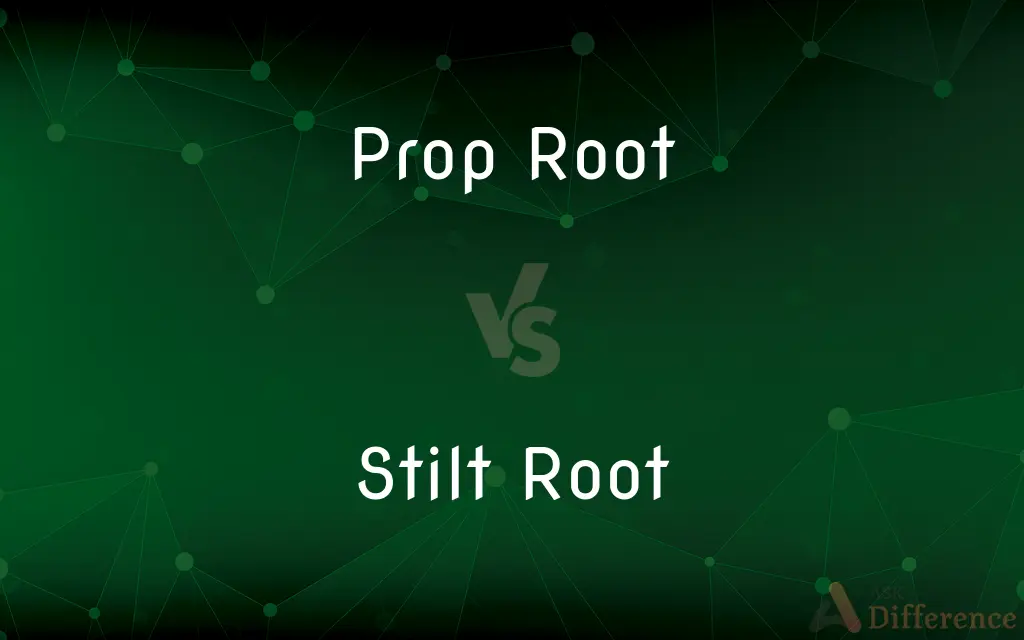Prop Root vs. Stilt Root — What's the Difference?
By Tayyaba Rehman — Published on January 10, 2024
Prop roots are aerial, supportive roots growing from the lower trunk of a plant, while stilt roots are slanted roots growing from the stem base, elevating the plant above the ground.

Difference Between Prop Root and Stilt Root
Table of Contents
ADVERTISEMENT
Key Differences
Prop roots develop from the lower part of the trunk and grow vertically downward, providing additional support to the plant. Stilt roots, however, emerge from the base of the stem, often at an angle, and help elevate the plant above the ground.
Prop roots are common in plants like corn and banyan trees, where they thicken and support large trunks. Stilt roots are characteristic of plants like mangroves, aiding in survival in unstable or aquatic environments.
The function of prop roots is mainly to provide structural stability, especially in tall or heavy plants. Stilt roots not only support the plant but also facilitate better aeration and nutrient absorption in poor soil conditions.
Prop roots can be quite extensive and conspicuous, forming a network around the base of the plant. In contrast, stilt roots tend to be fewer but more pronounced, often giving the plant an elevated appearance.
Prop roots are adaptive responses to support weight and withstand winds, while stilt roots are adaptations to waterlogged or swampy conditions, raising the plant above water or poor soil.
ADVERTISEMENT
Comparison Chart
Origin
From the lower trunk.
From the base of the stem.
Direction
Grow vertically downward.
Grow at an angle, often slanted.
Function
Provide structural support.
Support and elevate the plant, facilitate aeration.
Common Environments
Found in terrestrial plants like corn and banyan trees.
Common in aquatic environments like mangroves.
Adaptation
Support weight and withstand winds.
Adapt to waterlogged or swampy conditions.
Compare with Definitions
Prop Root
Prop roots are a form of aerial roots seen in many tree species.
The ancient fig tree spread its prop roots, creating a broad base.
Stilt Root
Stilt roots elevate the plant above the ground or water.
The stilt roots of the coastal plant lifted it above the high tide line.
Prop Root
Prop roots can become as thick and woody as the main trunk.
Over years, the prop roots of the tree grew to resemble additional trunks.
Stilt Root
Stilt roots are common in plants growing in unstable environments.
Pandanus trees on the beach were supported by a network of stilt roots.
Prop Root
Prop roots help plants anchor securely in the ground.
The prop roots of the tropical tree were deeply embedded in the soil.
Stilt Root
Stilt roots help plants like mangroves adapt to aquatic habitats.
The stilt roots of the mangroves created a unique intertidal ecosystem.
Prop Root
Prop roots extend vertically downward to provide extra stability.
Corn plants develop prop roots to stabilize their tall stems.
Stilt Root
Stilt roots provide stability and access to oxygen in waterlogged soils.
In the swamp, the tree’s stilt roots were vital for survival.
Prop Root
Prop roots are supportive roots that grow from a plant’s trunk.
The banyan tree's massive trunk was supported by numerous thick prop roots.
Stilt Root
Stilt roots are angled roots emerging from the stem base of a plant.
Mangrove trees use stilt roots to stay upright in muddy water.
Common Curiosities
Are stilt roots common in terrestrial plants?
They are more common in plants in waterlogged or aquatic environments.
Can stilt roots be found in non-mangrove plants?
Yes, other plants like Pandanus also have stilt roots.
Can stilt roots help in nutrient absorption?
Yes, stilt roots aid in nutrient absorption, especially in poor soil conditions.
How do prop roots benefit tall plants?
They help tall plants remain upright and stable.
Can stilt roots grow in dry conditions?
They are not typically found in dry conditions; they favor moist, unstable soils.
What is the main purpose of prop roots?
The main purpose is to provide structural support to the plant.
Do prop roots grow above ground?
Yes, prop roots are aerial roots that grow above the ground.
Can prop roots turn into trunks?
Over time, they can become thick and woody, resembling trunks.
Do all trees have prop roots?
No, only certain species like banyan trees develop prop roots.
What type of environment do stilt roots adapt to?
Stilt roots adapt to unstable, often aquatic or swampy environments.
Do prop roots help in water absorption?
Their primary function is support, but they may also help in water absorption.
Do stilt roots provide aeration to the plant?
Yes, they facilitate better aeration in swampy or waterlogged conditions.
Are prop roots a sign of poor soil quality?
Not necessarily; they are more a structural adaptation than a response to soil quality.
How do prop roots affect the soil?
They can help prevent soil erosion around the base of the plant.
Are stilt roots always visible above the ground?
Yes, stilt roots are typically visible as they grow above the ground.
Share Your Discovery

Previous Comparison
Atomic Radius vs. Ionic Radius
Next Comparison
Guided Media vs. Unguided MediaAuthor Spotlight
Written by
Tayyaba RehmanTayyaba Rehman is a distinguished writer, currently serving as a primary contributor to askdifference.com. As a researcher in semantics and etymology, Tayyaba's passion for the complexity of languages and their distinctions has found a perfect home on the platform. Tayyaba delves into the intricacies of language, distinguishing between commonly confused words and phrases, thereby providing clarity for readers worldwide.














































